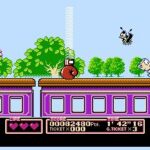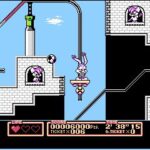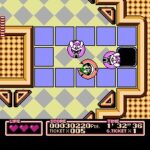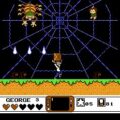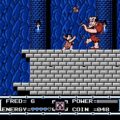Developer: Konami Publisher: Konami Release: 04/93 Genre: Platformer
Konami were one of the few publishers to support the NES at the end of its life. Their later output focused on licensed titles as they reserved their core intellectual properties for the 16-bit consoles. They picked some obscure ones; I doubt many had heard of Zen the Intergalactic Ninja back then. Hell I barely remember it now. Tiny Toon Adventures was a solid platformer if a bit generic. It would have been easy to pump out another cheap sequel. Instead Konami tried something different with Tiny Toon Adventures 2: Trouble in Wackyland, creating a minigame marathon instead of a platformer. What is here is decent, it just needs more of it.
Buster and his friends receive an invitation to the newly opened Fun House at Acme Acres theme park from a “secret” admirer. But things aren’t as easy as they seem. Before they can get in they must collect 4 golden tickets to gain entrance and find out who has been watching them from afar.
The main goal of Trouble in Wackyland is to collect enough gold tickets to access the Fun House to find your secret admirer. Each “ride” uses a set number of normal tickets to play. Each time you fail you need to use more but you can trade points for more tickets. Gold tickets are awarded upon completing each attraction and you only need four to reach the conclusion. You can also collect fifty normal tickets to do the same but that is mind numbingly slow. In essence you can play the game the way you want. If you find one particular game easy you play it repeatedly.
The extensive cast of characters is now active participants in the gameplay rather than just side characters or in adversarial roles. Plucky, Furrball, Hampton, and Babs Bunny each have their own individual attraction at the park. Buster only becomes available for the finale in the Fun House. The only platforming stages in the game is the Fun House; every other activity is a minigame. Furrball must survive a treacherous log ride, Plucky engages in a game of bumper cars, Babs must endure the roller coaster from hell while Hampton simply needs to make it to the conductor’s cabin on the train.
Despite the various games the controls are simple and intuitive. This is crucial as the difficulty varies from one game to the next. The simplest is the log ride. This leisurely stroll only challenges you to avoid the occasional enemy without falling off. The most complex is the roller coaster. You might catch a case of PTSD as it has a similar pacing to the Turbo Tunnel in Battle toads. Babs can flip the platform upside down to avoid obstacles which is called on frequently over the course of the ride. This one is pretty long and the pace varies wildly. You need to memorize the entire course of the ride to survive as the walls and enemies appear suddenly and you will need to flip in rapid succession to avoid damage. The difficulty spike on this one comes out of left field but not as bad as Rare’s title.
I dislike the bumper cars the most. This one is equal parts fun and frustrating. Over the course of three rounds your goal is to knock your opponents in to the sole open hole. You hold the button to build up energy to charge your opponents and break to slow down. The layout of each table changes between rounds for variety. The problem is everything is bunched together with bumpers leaving little room to move. That means you spend most of the time rebounding uncontrollably. It feels random more than a test of skill and the one I avoid for the sake of my sanity.
The remaining two activities are the closest you will get to a traditional platformer. Hampton’s journey on top of the train is the easiest after Furrball’s adventure. You defeat the enemies with a gut punch and hop from train car to train car. The Fun House is the closest to the first game. Buster’s controls are not as snappy; he does not run or jump as fast but his flip kick gives a little momentum to clear platforms. The maze is a little complex but not too long and it ends in the sole boss battle. It is a high note to end on but the game’s overall brevity will leave you wanting more.
In Closing
I can appreciate what they were going for with Trouble in Wackyland. But the game needs more meat on its bones. With a few more minigames and platforming stages it could have been excellent. Instead what we are left with is an appetizer of a game. You can pass on this one, you will not miss much.


